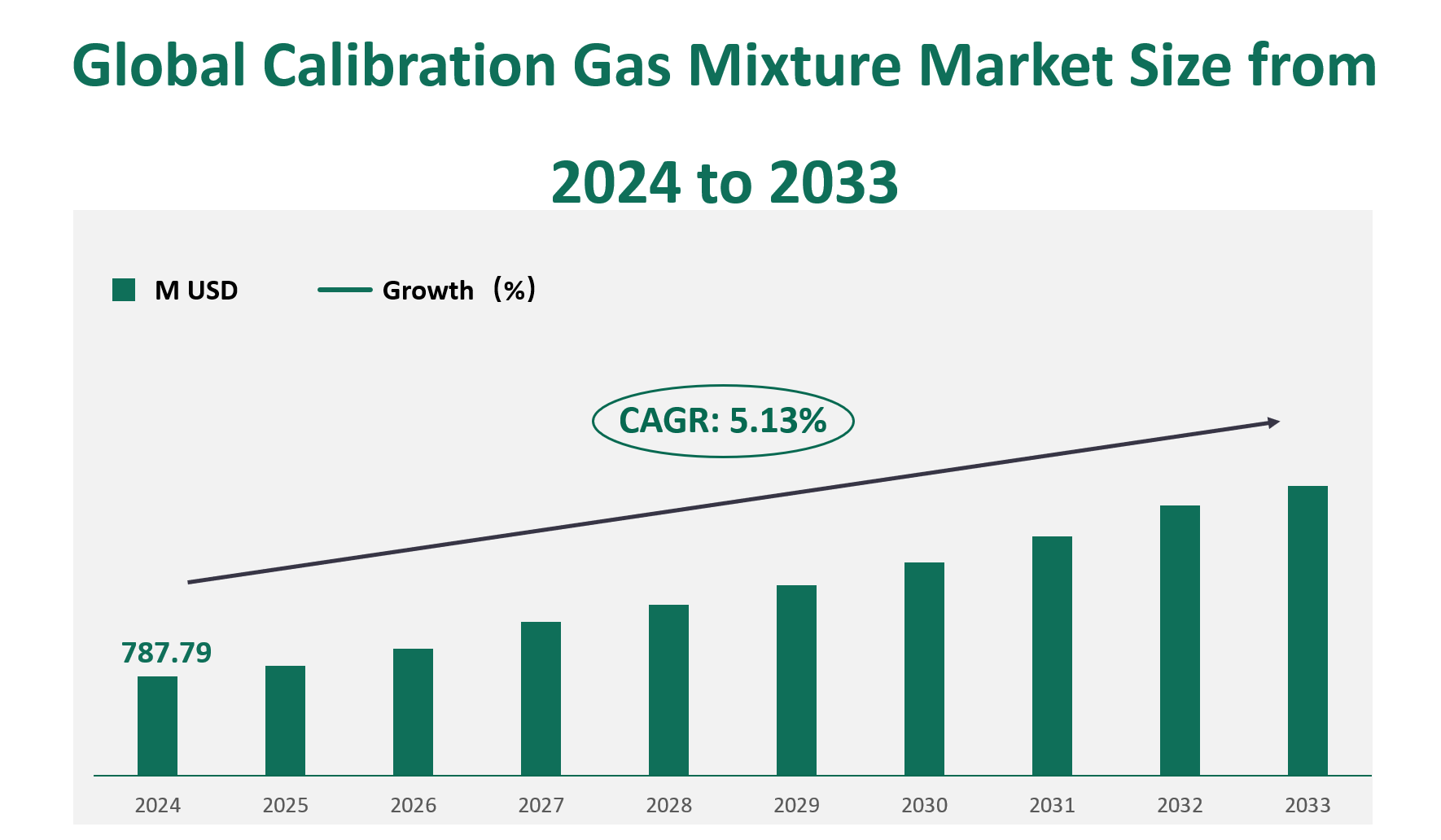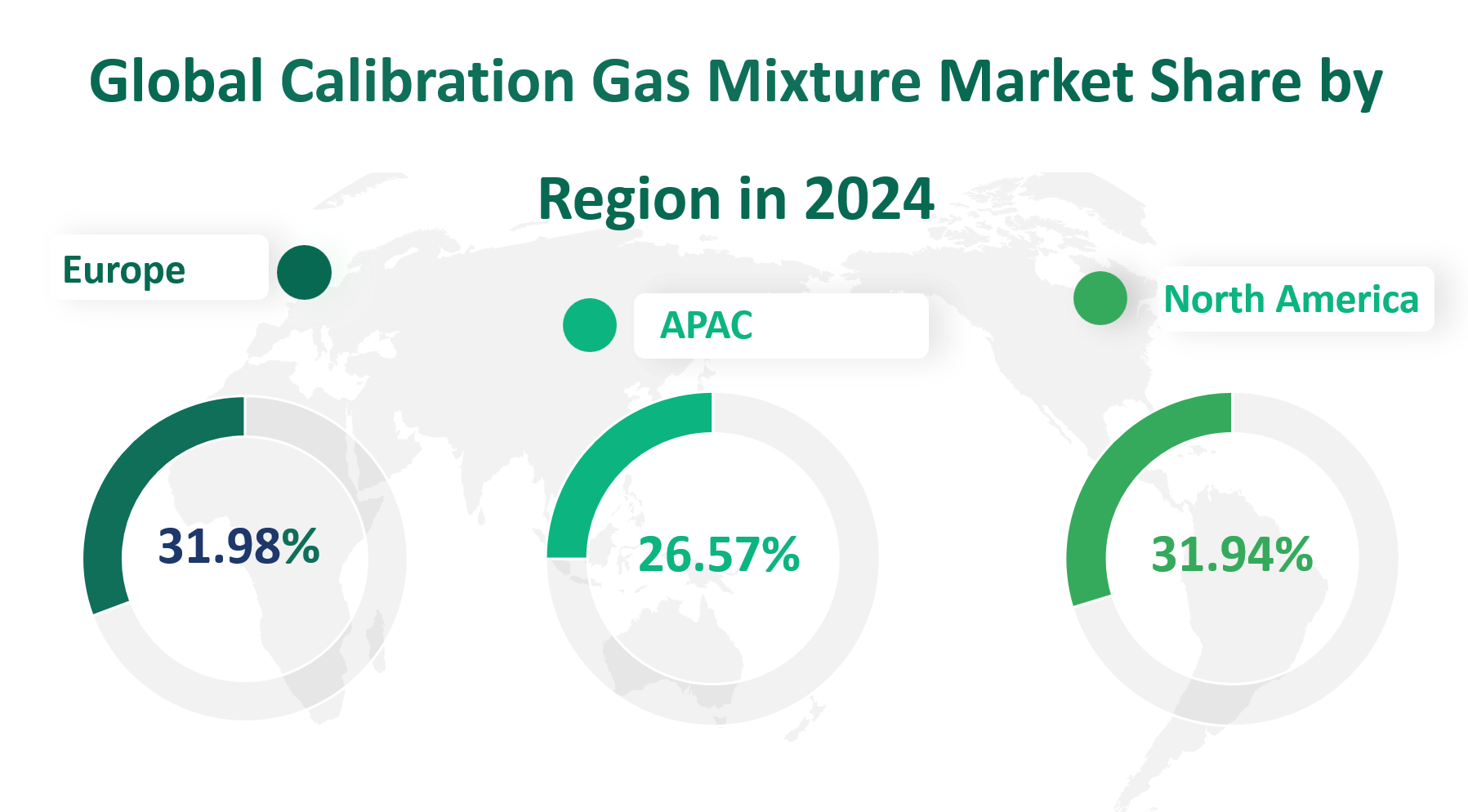1. Global Calibration Gas Mixture Market Insight Analysis
Calibration gas mixtures are essential tools used across various industries to ensure the accuracy and reliability of gas detection instruments. These mixtures are typically composed of one primary gas and one or more secondary components, designed to mimic real-world gas concentrations for calibration purposes. They are critical in industries such as environmental monitoring, oil and gas, automotive, and scientific research, where precise measurement and detection of gases are paramount. The calibration gases help in maintaining the accuracy of instruments that detect toxic gases, monitor emissions, and ensure compliance with environmental regulations.
In 2024, the Calibration Gas Mixture market revenue is projected to reach approximately 787.79 million USD. This growth is expected to continue in the coming years, with a Compound Annual Growth Rate (CAGR) of 5.13% from 2024 to 2033.
Figure Global Calibration Gas Mixture Market Size (M USD) and CAGR (2024-2033)

2. Driving and Limiting Factors of Calibration Gas Mixture Market Growth
The growth of the Calibration Gas Mixture market is driven by several key factors. One of the primary drivers is the increasing demand for worker safety in industrial settings. As awareness grows about the health risks associated with long-term exposure to toxic gases, the need for accurate calibration of gas detection instruments has become more critical. This demand is particularly high in industries such as oil and gas, where workers are frequently exposed to hazardous gases. Additionally, the growing demand for oil in developing countries has led to an increase in the number of oil platforms and refineries, which require regular calibration of their gas analyzers and detectors.
Another significant driver is the increasing stringency of environmental regulations. Governments around the world are implementing stricter regulations to control emissions and ensure environmental compliance. This has led to a higher demand for calibration gases used in testing and monitoring equipment. The automotive industry, for instance, is under increasing pressure to reduce emissions, leading to a greater need for calibration gases to test exhaust systems and emissions control devices.
However, the market also faces several limiting factors. One of the primary challenges is the fluctuation in raw material prices, which can significantly impact the cost of production. These fluctuations are influenced by factors such as supply and demand dynamics, currency fluctuations, and import/export tariffs. Additionally, the industry’s overall R&D and innovation capabilities are still relatively weak, with most products having low technical content and added value. This lack of innovation can hinder the market’s ability to meet the growing demand for high-end, specialized calibration gases.
3. Technological Innovation and Corporate Mergers and Acquisitions in the Calibration Gas Mixture Market
Technological innovation plays a crucial role in the Calibration Gas Mixture market. Advances in gas detection technologies have led to the development of more precise and reliable calibration gases. For instance, the introduction of high-purity gases and specialized mixtures has improved the accuracy of gas detection instruments. Additionally, the development of portable and easy-to-use calibration gas systems has made it easier for industries to maintain their equipment on-site, reducing downtime and improving operational efficiency.
Corporate mergers and acquisitions have also significantly impacted the market. Major players such as Linde Group, Air Products and Chemicals, and Air Liquide have been involved in strategic mergers and acquisitions to expand their market presence and enhance their product offerings. For example, the merger between Linde AG and Praxair Inc. in 2018 created the world’s largest industrial gas producer, Linde PLC. This merger aimed to leverage the combined strengths of both companies to offer a broader range of products and services. Similarly, Air Liquide’s acquisition of Tech Air in 2019 strengthened its distribution network in the United States, enabling it to better serve local customers.
4. Analysis of Different Product Types of Calibration Gas Mixture
Calibration gas mixtures are categorized into several types based on their composition and specific applications. The primary types include Ultra-High Purity (UHP) gases, Special Application Gas Mixtures, High End Gas Mixtures, EPA Protocol gases, and others.
Ultra-High Purity (UHP) Gases: UHP gases are characterized by their extremely low levels of impurities, making them ideal for applications requiring high precision and accuracy. These gases are used in industries such as semiconductor manufacturing, pharmaceuticals, and high-tech research. In 2024, the market revenue for UHP gases is forecasted to reach approximately 76.78 M USD.
Special Application Gas Mixtures: These mixtures are tailored for specific industrial applications, such as environmental monitoring, biomedical research, and power generation. They are designed to meet stringent regulatory standards and provide high reliability. The market revenue for Special Application Gas Mixtures in 2024 is projected to be around 149.27 M USD.
High End Gas Mixtures: High End Gas Mixtures are composed of specialized gases with high purity and reliability. They are used for calibrating advanced emission monitoring equipment and gas detection systems. The market revenue for High End Gas Mixtures in 2024 is expected to be around 270.67 M USD.
EPA Protocol Gases: EPA Protocol gases are specifically designed to comply with the regulations set by the United States Environmental Protection Agency (EPA). These gases are used to measure emissions of regulated gaseous species, ensuring compliance with environmental standards. The market revenue for EPA Protocol gases in 2024 is forecasted to be approximately 176.13 M USD.
Table Global Calibration Gas Mixture Market Size by Type in 2024
Market Size (M USD) 2024 | Market Share | |
UHP | 76.78 | 9.75% |
Special Application Gas Mixtures | 149.27 | 18.95% |
High End Gas Mixtures | 270.67 | 34.36% |
EPA Protocol | 176.13 | 22.36% |
Others | 114.94 | 14.59% |
5. Analysis of Different Applications of the Calibration Gas Mixture Market
Industrial applications of calibration gas mixtures include environmental monitoring, equipment testing, engine emission testing, oil and natural gas measurement, and gas detection. These applications are crucial for ensuring the reliability and accuracy of industrial processes. The market revenue for Industrial Use in 2024 is forecasted to reach approximately 551.47 M USD.
In the scientific and research sector, calibration gas mixtures are used to calibrate various analytical instruments and gas analyzers in laboratories and research centers. These mixtures ensure accurate readings and reliable data. The market revenue for Science and Research in 2024 is projected to be around 167.66 M USD.
Table Global Calibration Gas Mixture Market Size by Application in 2024
Application | Market Size (M USD) 2024 | Market Share |
Industrial use | 551.47 | 70.00% |
Science and research | 167.66 | 21.28% |
Other | 68.66 | 8.72% |
6. Global Calibration Gas Mixture Market Size by Region
North America remains the largest market by revenue, with a projected revenue of 251.60 million USD in 2024. This region’s dominance is attributed to its well-established industrial base, particularly in the United States and Canada. The presence of major players and a strong emphasis on worker safety and environmental compliance further bolster the market.
Europe follows closely with a projected revenue of 251.90 million USD in 2024. The European market is characterized by stringent environmental regulations and a high demand for calibration gases in industries such as automotive, chemical, and manufacturing.
Asia Pacific is the fastest-growing region, with a projected revenue of 209.29 million USD in 2024. The region’s growth is fueled by rapid industrialization, particularly in China, Japan, and South Korea. The increasing demand for calibration gases in emerging economies such as India and Southeast Asia further drives the market.
Latin America and the Middle East & Africa are smaller markets but are also experiencing growth. Latin America is projected to reach 41.61 million USD in 2024, driven by countries such as Mexico and Brazil. The Middle East & Africa region is projected to reach 33.38 million USD in 2024, with significant contributions from countries like Turkey, Saudi Arabia, and the UAE.
Figure Global Calibration Gas Mixture Market Size by Region in 2024

7. Global Calibration Gas Mixture Market Analysis by Major Players
7.1 Linde Group
Introduction and Business Overview: Linde Group is a world-leading supplier of industrial, process, and specialty gases. Established in 2017, the company operates in over 100 countries and is known for its high-quality products and innovative solutions.
Products Offered: Linde Group offers a wide range of calibration gases, including UHP gases, special application gas mixtures, high-end gas mixtures, and EPA protocol gases. These products are used in various applications, from industrial use to scientific research.
7.2 Air Products and Chemicals
Introduction and Business Overview: Air Products and Chemicals is a global leader in the industrial gases industry, with a history dating back to 1940. The company provides industrial gases and related equipment to a wide range of industries, including refining, chemicals, metals, electronics, and food and beverage.
Products Offered: Air Products and Chemicals offers a comprehensive range of calibration gas mixtures, including UHP gases, special application gas mixtures, high-end gas mixtures, and EPA protocol gases. The company is known for its extensive product line and high-quality standards.
7.3 Air Liquide
Introduction and Business Overview: Air Liquide, established in 1902, is a world leader in gases, technologies, and services for industry and health. The company operates in 80 countries and serves over 3.7 million customers and patients.
Products Offered: Air Liquide offers a diverse range of calibration gases, including UHP gases, special application gas mixtures, high-end gas mixtures, and EPA protocol gases. The company is renowned for its high-precision gas mixtures and advanced filling systems.

